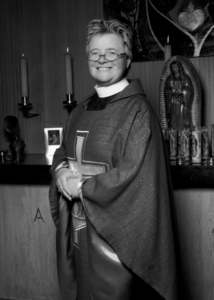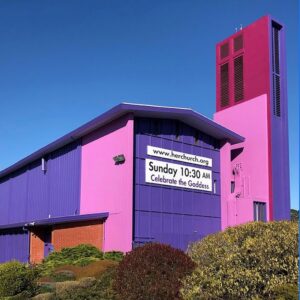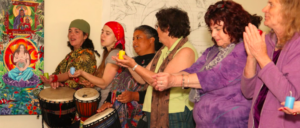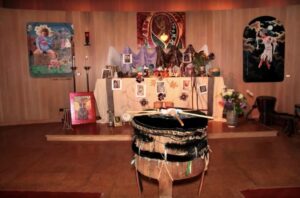FOUNDER/GROUP HISTORY
1882: Ebenezer Lutheran Church was established in San Francisco to serve Swedish immigrants.
1956: The current church building was erected, but membership declined as the Swedish immigrant population aged.
1958: Stacy Boorn was born.
1987: Stacy Boorn graduated from Pacific Lutheran Theological Seminary in Berkeley, California, and was ordained by the Association of Evangelical Lutheran Churches.
1988: Evangelical Lutheran Church in America (ELCA) formed, the Association of Evangelical Lutheran Churches became a part of this group.
1990: The Lutheran Lesbian & Gay Ministries formed to provide financial support for calls to LGBTQIA+ pastors.
1993: The Extraordinary Candidacy Project formed to provide a credentialing process for publicly-identified LGBTQIA+ people called to Lutheran ministry.
1998 (November): Stacy Boorn becomes full-time interim mission-assessor pastor at Ebenezer Lutheran Church.
1999: Pastor Boorn, with the parents’ permission, baptized a child “in the name of God who is our Mother and our Father and in the name of Jesus, who is the child of God.”
2002: The congregation began using the name herchurch after erecting the banner, “Everybody welcome at the table. Sunday morning worship at 10:30 a.m. God loves all Her children!”, on the church exterior.
2003: herchurch began using female imagery in its liturgies.
2006 (November 16): Megan Rohrer, the ELCA’s first transgender pastor, was ordained in a joint call from herchurch (Ebenezer Lutheran), Christ Church Lutheran, St. Francis Lutheran and Sts. Mary and Martha Lutheran.
2007: The Extraordinary Candidacy Project and Lutheran Lesbian & Gay Ministires merged to form Extraordinary Lutheran Ministries to support ministry opportunities for LGBTQIA+ Lutherans.
2007 (November): The first herchurch Faith and Feminism conference held, titled “Wisdom’s Urgent Cry: A Faith and Feminism/Womanist/Mujerista Conference.”
2008 (June-November): herchurch officiated seven same-sex marriages for members during the period when same-sex marriage was legal in California.
2010 (July): The ELCA welcomed its first seven openly gay pastors, who had been previously ordained extraordinarily by the ELM.
FOUNDER/GROUP HISTORY
Like other mainstream Protestant denominations the Lutherans have been experiencing conservative-progressive divisions for several decades, and most recently over sex and gender identity issues. While the Missouri Synod and Wisconsin Evangelical Lutheran Synod components of the denomination have maintained more conservative positions, the Evangelical Lutheran Church in America (ELCA) has gradually adopted more progressive positions, particularly on the ordination of LGBTQIA+ pastors.
San Francisco, of course, historically has been a major center of a variety of countercultural groups and activities, including religion. In addition to the Lutheran Church advocacy of LGBTQIA+ initiatives, there are a number of other religious and spiritual groups with parallel agendas. For example, the Metropolitan Community Church, which has planted churches across the country, was established here. The sizable Methodist affiliated Glide Memorial Church officiated the first same-sex union ever held in a United Methodist Church (Kane 2015). The San Francisco Buddhist Center hosts both the Gay Buddhist Fellowship and the San Francisco LGBT Sangha. And, of course, San Francisco is home to the highly visible Sisters of Perpetual Indulgence.
Challenges to established mainstream positions have taken two primary forms, acceptance of LGBTQIA+ ordination and assertion of feminist spirituality. Not surprisingly, the ordination challenge began with two San Francisco Lutheran churches, St. Francis Lutheran Church and First United Lutheran Church. These two congregations extended “calls” to already open gay and lesbian pastors, even though this was in violation of ELCA policy. In 1990, this movement became the Lutheran Lesbian & Gay Ministries; in 1993, the Extraordinary Candidacy Project; and in 2007, the Extraordinary Lutheran Ministries (ELM). ELM took a more aggressive approach to gay and lesbian ordination by creating a credentialing process for already publicly identified gays and lesbians called to the Lutheran ministry. The ELCA formed a task force in 2001 to study the ordination issue (Goodstein 2010). When ELCA policy was slow to change, particularly after the 2005 national gathering, individual Lutheran congregations began extending calls to LGBTQIA+ pastors despite potential disciplinary action. There were ten extraordinary ordinations between 2006 and 2009. Subsequently the number of LGBTQIA+ rostered leaders (seminarians and candidates) has grown to over 350 (ELM). In 2009, ELCA reversed its longstanding ordination policy by approving the ordination of monogamous noncelibate gay pastors. Seven self-identified gay pastors in 2010 (who had already been ordained and were serving at churches or outreach ministries without being included on the official clergy roster) were accepted in a ceremony at St. Mark’s Lutheran Church in San Francisco officiated by ELM (Goodstein 2010). One of those was Megan Roher, who is transgender and later became the first ELCA bishop (Eg1s0Zh1 2021). This policy shift made ELCA the largest Protestant church in the United States to permit noncelibate gay ministers to serve in the ranks of its clergy. At the same time, there also was organized opposition. to the changes. A group of conservative Lutheran churches, Lutheran Core, announced its intention to create a new denomination, the North American Lutheran Church (Goodstein 2010).
Ebenezer Lutheran Church chose a second path that also challenged traditional Lutheran organization and practice. What became known as herchurch developed as its mission the incorporation of the divine feminine into doctrine and practice so as to counterbalance patriarchal dominance in Lutheranism specifically, and Christianity more generally. herchurch has been open to LGBTQIA+ordination, but has not made ordination policy its primary mission. For example, it joined with several other ELCA churches in the ordination of the denomination’s first transgender pastor (Green 2010). The church congregation also includes a number of LGBTQIA+ members. During the brief period in 2008 when same-sex marriage was permitted under California law, her church performed several marriage ceremonies (Ursic 2014). Since Stacy Boorn assumed the role of pastor at Ebenezer, the church has steadily increased the integrality of the divine feminine in its doctrines, rituals and organization. The prominence of the divine feminine has also been heightened by the opposition it has aroused in the more conservative elements of ELCA.
While Ebenezer Lutheran Church traces its history to its founding in San Francisco in 1882, during California’s gold rush days, as a church serving Swedish immigrants. However, its current history begins with the arrival of Pastor Stacy Boorn in 1998. Boorn grew up in the Missouri Synod Lutheran denomination, which does not ordain women as pastors (Aldredge-Clanton 2011). She reports having strong religious interests from a young age: “As a little girl, I loved the Lutheran hymns. I would take my hymnal into the bath and sing my heart out!” (Ursic 2014)
When she was only nine years old, Stacy Boorn announced, “I want to be a pastor. God wants me to do this.” Even though she was growing up in a church that was part of the Missouri Synod Lutheran denomination, that still doesn’t ordain women, she didn’t realize then that women were prohibited from being pastors (Aldredge-Clanton 2011). She participated in confirmation classes at Trinity Lutheran Church in Schenectady, New York, and by the time she was in college had self-declared as a pre-seminarian at Concordia Bronxville, a Missouri Synod college (Aldredge-Clanton 2011; Ursic 2014). After graduating from Pacific Lutheran Theological Seminary in 1987 and being ordained by the Association of Evangelical Lutheran Churches (which joined the Evangelical Lutheran Church in America the following year), Boorn accepted a position of pastor at the small Grace Lutheran Church in Richmond, California, with a predominantly Laotian immigrant congregation, in 1989 (Aldredge-Clanton 2011). She held that position until 1998 when she accepted the pastor position at Ebenezer Lutheran Church in San Francisco. She followed a pastor who had led the church for twenty-four years (Ursic 2014).

When Boorn arrived at Ebenezer Lutheran, [Image at right] there had been a reduced flow in immigration from Sweden and earlier immigration cohorts had distanced from their ethnic histories (Ursic 2014). Further, the younger age cohorts were suburbanizing. Ebenezer was not unique in this respect as most of the ten churches in the San Francisco Conference of the ELCA faced similar pressure (Ursic 2014).
Boorn began a broad based campaign to change the church culture. Some aspects of her leadership, like creating more openness, were received positively. At the same time other initiatives, such as welcoming LGBTQIA+ community members reflected were less well received, as was the case within the ELCA at that time.
It was during this period that Boorn discovered feminist theology and began thinking about how to incorporate a “more inclusive understanding of the divine” into the church (Mantle 2010). She was influenced by feminist authors such as Rosemary Radford Ruether, author of Sexism and God-Talk. Her exploration led to a baptism “in the name of God who is our Mother and our Father and in the name of Jesus, who is the child of God” (Aldredge-Clanton 2011; Ursic 2014). This was followed in 2002 by the placement of a banner across the front face of the church stating that “Everybody welcome at the table. Sunday morning worship at 10:30 a.m. God loves all Her children!” (Aldredge-Clanton 2011). It was when the church then launched a website that the name herchurch was coined (herchurch is never capitalized in  order to emphasize the church’s radical egalitarianism (Ursic 2014)). It thus became Ebenezer/herchurch Lutheran Church. The striking purple and periwinkle exterior of the church added an exclamation point to their mission of promoting the feminine divine. [Image at right]
order to emphasize the church’s radical egalitarianism (Ursic 2014)). It thus became Ebenezer/herchurch Lutheran Church. The striking purple and periwinkle exterior of the church added an exclamation point to their mission of promoting the feminine divine. [Image at right]
The turmoil over Boorn’s initiatives, particularly the issue of the feminine divine, continued and ultimately led to a vote by the congregation over her continuation as pastor. It was a pivotal moment in the church’s history, with sacralization of the feminine as the symbolic point of contestation. She survived that challenge, which led all but five of the original congregation members to withdraw from the congregation (Kane 2015). Boorn and her supporters then moved ahead with their agenda by creating more inclusive language in hymns and prayers (“Mother-Father God,” “God/dess,” “Christ-Sophia,” and Holy Other) displaying more female imagery in the sanctuary, emphasizing social justice issues concerning women, and creating a lending library of Christian feminist authors in the church. herchurch thus describes itself as a “Lutheran feminist movement that exists to celebrate feminine dimensions of the sacred as expressed in worship, learning, mutual care, and acts of justice” (Ursic 2014).
We strive to be an open and affirming community. All persons are welcome and loved in the love of Christ-Sophia and the Great Mother of us All. This an exciting time. Even though we have been in God/dess’ service in the City since 1882, we are birthing a new congregation. We are always becoming a community of hospitality, which expresses inclusivity through word/wisdom and worship, deed and ministry programming.
All expressions of gender identity are a blessing! (herchurch website 2022)
DOCTRINES/BELIEFS
Ebenezer Lutheran had been “very much a traditional Lutheran congregation,” with a shrinking membership base, prior to Stacy Boorn’s arrival (Mantle 2010). Boorn articulated a new church mission, one that advanced a more prophetic mission for the pastor:
Our mission is to embody and voice the prophetic wisdom and word of the Divine Feminine, to uplift the values of compassion, creativity and care for the earth and one another (herchurch website 2022).
Ultimately this would challenge the patriarchal church structure:
The mission of Ebenezer/herchurch Lutheran is to be a prophetic voice within the patriarchal church. Inclusion of the Divine Feminine will change the whole structure of the church. Eventually the clergy structure will be dismantled. The inclusion of the Sacred Feminine empowers women and men to look at alternative structures, to change power structures that leave people out or belittle them or give a person power over others. Exclusively masculine language for Deity supports those structures. Egalitarian language for the Holy Other supports egalitarian communities” (Aldredge-Clanton 2011).
RITUALS/PRACTICES

herchurch developed, adopted, or adapted a number of rituals that emphasized its prophetic, feminist orientation. [Image at right] The Sunday service is titled “The Liturgy of the Divine Feminine.” There is a Goddess Rosary, which Boorn had discovered at a meeting with feminist Lutheran pastors (Ursic 2014). The Goddess Rosary includes prayers that are intended to be liberating and empowering: “Our Mother Who is Within Us,” by Mariam Teresa Winters, a Roman Catholic Feminist, and “Hail Goddess Full of Grace,” by Carol Christ, a Goddess Feminist (herchurch website 2022; Ursic 2014).
Our Mother (by Miriam Therese Winter)
Our Mother who is within us, we celebrate your many names.
Your wisdom come, your will be done, unfolding from the
depths within us. Each day you give us all that we need. You
remind us of our limits and we let go. You support us in our
power and we act with courage. For you are the dwelling place
within us, the empowerment around us, and the celebration
among us. Now and forever. Amen.Hail Goddess (adapted from Carol Christ)
Hail Goddess, full of grace, Blessed are You and blessed is
the fruit of your womb. For you are the mother of us all.
Hear/ Heal us now and in all our needs/ dreams. O blessed
be, O blessed be, Amen.

There is also a croning ceremony to honor older women that is borrowed from the Goddess movement.
The church altar clearly features feminist spiritual themes. Most of the artwork in the church and on its website depict the Goddess/divine feminine over common masculine depictions of God (Ursic 2014). herchurch also developed a ChristSophia Mass for the fourth Sunday of Advent, which is intended to balance the masculine and feminine. Masses in the preceding three weeks are performed honor the return of and returning to the Ancient Mother (Advent 1), the Black Madonna (Advent 2) and the Guadalupe (Advent 3). There is a distinctive quality to the ChristSophia Mass:
It is not a feminization of the traditional Christmas or a New-Age-Goddess-take on the Solstice. Advent at herchurch is about returning. The season and word itself is about coming, hope, and the anticipation of re/birthing the divine in her world. It is also a season of darkness in which we often retreat into ourselves or the darkness of the unconscious. This darkness is both holy and safe. It is the darkness of the Divine Womb (herchurch website 2022).
Outside of the more formal church activities, the church organized a number of “circles” that reflected divine feminine themes: Goddess/Holy Woman Icon Making, Tactile Spirituality, Full Moon Drum Circle, Soul Collage. Each November the church has sponsored an annual Faith and Feminism, Womanist, Mujerista Conference (feast) onsite. (herchurch website 2022).
In 2008, California briefly legalized same-sex marriage until passage of the Proposition 8 constitutional initiative prohibited same-sex marriage. During this period herchurch organized marriage rituals and officiated seven same-sex marriages for church members (Ursic 2014).
ORGANIZATION/LEADERSHIP
The strong feminist flavor of Ebenezer/herchurch is evidenced in the titles of leadership: Pastor and Priestess of Ritual; Sister of Song, Art Womb, SoulCollage; Resident Witch; Healing Circle, Artist; gender expansive ministry/Thea-logian; spiritual director, Goddexx enthusiast (herchurch website 2022). herchurch also displays artwork with a feminist  perspective, some of it produced by Boorn. [Image at right]
perspective, some of it produced by Boorn. [Image at right]
Boorn’s vision for herchurch clearly has both political and religious dimensions. In response to a query about her “wishes” for the church, she listed three:
A true equality and divinity for all sentient beings.
The spiritual community I’m involved with (herchurch) will expand and engage more creative and peace-seeking folks. Open invitation: Sundays at 10:30 am.
ISSUES/CHALLENGES
herchurch has remained a member of the Evangelical Lutheran Church in America; however, it has consciously remained at the edge of that denominational tradition. As a result of its tradition-challenging agenda it has continued to face difficulty in increasing its membership base, resistance to gaining more prominent status within the church hierarchy, and generated ongoing vocal opposition to its feminist orientation.
When Stacy Boorn arrived at Ebenezer Lutheran Church as pastor, the historic church was in decline. Her assertion of a new direction for the church led to additional defections even as it became known as herchurch and gained increased visibility and publicity. The ECLA (2022) reported 200 baptized members, 188 confirmed members, with twenty onsite attendees and sixty-five online attendees on average (ECLA 2022). Regular church membership thus has remained well under 100 in a building constructed for a much larger congregation. Only a few members from the pre-herchurch days remain. Rather, herchurch has created a unique identity that has attracted a small band of predominantly female, white, enthusiastic feminist Lutherans and has seamlessly included gays and transgenders, but the church’s membership growth initiatives have yet to attract more mainstream Lutherans in significant numbers (Kane 2015; Aldredge-Clanton 2015; Rice 2022; Ursic 2014).
herchurch’s identity has left it in a somewhat awkward position within the denomination organizationally. While the church has supported the Extraordinary Lutheran Mission in certain ways, it has not made LGBTQIA+ issues its primary focus, which remains feminist spirituality. Since the church’s mission is so closely associated with Boorn’s leadership, this has translated into status issues for Boorn. For example, she was interested in serving on the regional synod council, but her candidacy was not successful beyond the local level. As Boorn noted, “I learned that I am not electable to those kinds of things because I’m too out there for some people, pushing for feminism to be heard within the church” (Goodstein 2010).
Finally, herchurch has met vocal opposition from more conservative elements within ELCA. The central issue has continued to be the church’s emphasis on the divine feminine. For example, herchurch has substituted “Our Mother” for “Our Father” at the beginning of the Lord’s Prayer. One critic responded that “This prayer is not suitable for use in true Christian worship; avoid it entirely. Choose a standard translation of the Lord’s Prayer instead, in order to truly pray the prayer that Jesus taught us” (Dennis 2022). A former pastor, Tom Brock, who withdrew his congregation from ELCA in response to liberalized denominational policies, referred to herchurch’s assertion of a divine feminine as “arrogant.” He stated that “Jesus taught us ‘Our Father who art in heaven.’ For us to change the Lord’s prayer is arrogant” (Garday 2019).
Other critiques have been more harsh, asserting that herchurch could not be considered Lutheran (Ursic 2014):
Please do not claim to be Lutheran. You mock all things of our faith!!! This is an abomination. There is nothing Christian about ignoring God’s Word and creating a pagan goddess worship religion. You are not Lutheran and it is offensive that you claim you are. Nothing in Scripture or our Confessions supports what you are doing. This is paganism. Ms Boorn I call you to repentance. To the Congregation at HerChurch, repent and leave now Romans 16:17.
The most persistent condemnation has come from the web-based Exposing the ECLA. The site regularly excoriates Boorn and the ECLA for a variety of deviations from traditional Lutheran doctrinal positions (Exposing the ECLA website 2021).
The drumbeat of criticism of herchurch has not produced denominational condemnation or sanctions. As one representative asserted, “We have no authority to intervene or override” decisions “made locally” because “congregations are separately incorporated and self-governing” (Gardey 2019). Given the continuing liberalization of ECLA and the withdrawal of several hundred conservative ECLA congregations, herchurch finds itself in a much less vulnerable position than it had occupied when Pastor Boorn introduced worship of the divine feminine.
IMAGES
Image #1: Stacy Boorn.
Image #2: herchurch.
Image #3: Ritual at herchurch.
Image #4: Stacy Boorn’s The Tree Goddess.
Image #5: The altar in herchurch.
REFERENCES
Aldredge-Clanton, Jann. 2011. “Changing Church: Rev. Stacy Boorn, Pastor, Ebenzer/herchurch Lutheran San Francisco, California.” Jann Aldredge-Clanton, November 18. Accessed from https://jannaldredgeclanton.com/changing-church-rev-stacy-boorn-pastor-ebenezerherchurch-lutheran-san-francisco-california-2/ on 1 October 2022.
Aldredge-Clanton, Jann. 2015. “V-Day, One Billion Rising, at Ebenezer/herchurch Lutheran.” Jann Aldredge-Clanton, February 18. Accessed from https://jannaldredgeclanton.com/v-day-one-billion-rising-at-ebenezerherchurch-lutheran/ on 19 September 2022.
Eg1s0Zh1. 2021. “Lutheran Church Installs 1st Transgender Bishop. A “They”.” Believers Portal, September 12. Accessed from https://believersportal.com/lutheran-church-installs-1st-transgender-bishop-a-they/ on 10 November 2022.
ELCA. 2022. “Ebenezer Lutheran Church.” search.ecla.org, October 27. Accessed from https://search.elca.org/Pages/Location.aspx?LocationID=de3ed871-0836-446a-85b5-20b55cf37276&LocationType=Congregation on 6 November 2022.
Gardey, Ellie. 2019. “Official Lutheran Church Practices Goddess Worship: Shamanic Journeying, Crystals, and A Sacred Dance to Ishtar.” The Daily Caller, July 2. Accessed from https://dailycaller.com/2019/07/02/lutheran-church-god-woman-goddess-worship/ on 6 October 2022.
Goodstein, Laurie. 2010. “Lutherans Offer Warm Welcome to Gay Pastors.” The New York Times, July 25. Accessed from https://www.nytimes.com/2010/07/26/us/26lutheran.html on 1 October 2022.
Green, Sharei. 2012. “Herconference: Faith & Feminism, Womanist and Mujerista Conference.” ELM.org, October 25. Accessed from https://www.elm.org/2012/10/25/herconferencefaith-feminism-womanist-and-mujerista-conference/ on 12 October 2022.
Green, Sharei. 2010. “The Rev. Megan Rohrer.” ELM.org, July 5. Accessed from https://www.elm.org/2010/07/05/megan-rohrer/ on 17 October 2022.
Kane, Peter Lawrence. 2015. “Unorthodox: S.F.’s Counterculture Churches Offer a Road to Redemption.” SF Weekly, March 18. Accessed from https://archives.sfweekly.com/sanfrancisco/peter-lawrence-kane-unorthodox-churches-herchurch-metropolitan-community-church-glide-memorial/Content?oid=3481421 on 3 November 2022.
Kennedy, Kit. 2022. “Pastor Stacy Boorn of herchurch Shares Her Art and Creative Wisdom.” San Francisco Bay Times, November 13. Accessed from https://sfbaytimes.com/pastor-stacy-boorn-herchurch-shares-art-creative-wisdom/ on 10 November 2022.
Mantle, Jennifer A. 2010. “Circling the Goddess: Reclaiming the rosary in Her name.” Institute of Transpersonal Psychology, June 2. Accessed from https://www.proquest.com/docview/861918291?pq-origsite=primo on October 5, 2022.
Rice, Ayslin. 2021. “Divine Feminine.” herchurch.org, October 15. Accessed from https://www.herchurch.org/about/divine-feminine on 13 October 2022.
Rice, Ayslin. 2021. “ChristSophia Mass.” herchurch.org, October 23. Accessed from https://www.herchurch.org/about/christsophia-mass on 13 October 2022.
Rice, Ayslin. 2021. “Our Purpose.” herchurch.org, October 18. Accessed from https://www.herchurch.org/about/our-purpose on 13 October 2022.
Rice, Ayslin. 2021. “Goddess mural: paint us into being.” herchurch.org, October 15. Accessed from https://www.herchurch.org/about/goddess-mural on 13 October 2022.
Skogen, Dan. 2010. “Making Idols of Canaanite goddess, Is that Still Okay, ELCA Leadership?” Exposing the ELCA, November 4. Accessed from https://www.exposingtheelca.com/exposed-blog/elca-and-false-god on 10 October 2022.
“ELM History.” 2022.Extraordinary Lutheran Ministries: Queer Seminarians & Rostered Leaders in the Lutheran Church, October 16. Accessed from https://www.elm.org/history/ on 16 October 2022.
Ursic, Elizabeth. 2014. “The Resource of Evangelization: Lutheran herchurch.” SUNY Press. Women, Ritual, and Power, September 30.
Nelson, Dennis. 2022. “The Lord’s Prayer at herchurch.” CORE: Lutheran Coalition for Renewal, January 18. Accessed from https://www.lutherancore.website/2022/01/18/the-lords-prayer-at-herchurch/ on 27 September 2022.
“Priestexx: we are She.” 2022. herchurch.org, October 10. Accessed from https://www.herchurch.org/priestexx on 12 October 2022.
Publication Date:
15 November 2022
